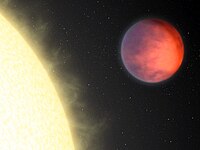Upsilon Andromedae b
Upsilon Andromedae A | |
| Physical characteristics | |
|---|---|
Mean radius | ~1.8[2]RJ |
| Mass | 1.70+0.33 −0.24[1] MJ |
Upsilon Andromedae b (υ Andromedae b, abbreviated Upsilon And b, υ And b), formally named Saffar
In July 2014 the
Discovery
Upsilon Andromedae b was detected by the variations in its star's
Like
A limitation of the radial velocity method used to detect Upsilon Andromedae b is that only a lower limit on the
Physical characteristics

Given the planet's high mass, it is likely that Upsilon Andromedae b is a gas giant with no solid surface.
The
The chemical elements in the atmosphere can be studied by finding their absorption lines in the thermal spectrum of the planet; given typical planet temperatures, the spectrum has its peak at infrared wavelengths. So far, only water vapor has been detected in this planet, while carbon monoxide and methane are still under the detection limit.[1]
The planet is unlikely to have large moons, since tidal forces would either eject them from orbit or destroy them on short timescales compared to the age of the system.[12]
The planet (with
Host star
The planet orbits a (F-type) star named Titawin (Upsilon Andromedae A). The star has a mass of 1.27 M☉ and a radius of around 1.48 R☉. It has a temperature of 6,074 K and is 3.12 billion years old. In comparison, the Sun is about 4.6 billion years old. The star is slightly metal-rich, with a metallicity ([Fe/H]) of 0.09, or about 123% of the solar amount. Its luminosity (L☉) is 3.57 times that of the Sun.
The star's apparent magnitude, or how bright it appears from Earth's perspective, is 4.09. Therefore, Upsilon Andromedae can be seen with the naked eye.
Effect on the parent star

Upsilon Andromedae b appears to be responsible for increased
See also
References
- ^ S2CID 19960378.
- ^ S2CID 118409453.
- ^ NameExoWorlds: An IAU Worldwide Contest to Name Exoplanets and their Host Stars. IAU.org. 9 July 2014
- ^ "NameExoWorlds The Process". Archived from the original on 2015-08-15. Retrieved 2015-09-05.
- ^ Final Results of NameExoWorlds Public Vote Released, International Astronomical Union, 15 December 2015.
- ^ "NameExoWorlds The Approved Names". Archived from the original on 2018-02-01. Retrieved 2016-01-17.
- doi:10.1086/310444.
- S2CID 119067572. (web version)
- S2CID 20549014.
- S2CID 16004653.
- S2CID 13978248.
- S2CID 14508244.
- S2CID 8684361.
- arXiv:1109.3116 [astro-ph.EP].
- S2CID 238198093
- S2CID 3043910.
External links
- "A Triple-Planet System Orbiting Ups Andromedae". San Francisco State University. Lick Observatory. Retrieved 2008-06-23.
- "Mystery Solved: How The Orbits Of Extrasolar Planets Became So Eccentric". SpaceDaily. 2005-04-14. Retrieved 2008-06-23.
- "NASA's Spitzer Sees Day and Night on Exotic World". NASA. Spitzer Space Telescope. 2006-10-12. Archived from the original on October 22, 2007. Retrieved 2008-06-23.
- "Upsilon Andromedae". The Internet Encyclopedia of Science. Retrieved 2008-06-23.
- "Upsilon Andromedae". The Planet Project. Archived from the original on 2008-05-18. Retrieved 2008-06-23.
- "Upsilon Andromedae 2". SolStation. Retrieved 2008-06-23.
- "The Upsilon Andromedae Planetary System". Harvard-Smithsonian Center for Astrophysics. Retrieved 2008-06-23.

